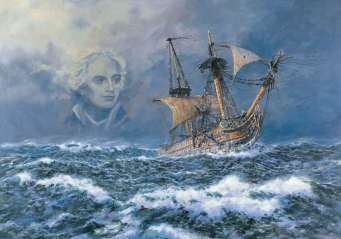On the 23rd of October a sortie by French Commodore Julien Cosmao from Cadiz with Pluton, Indomptable, Neptuno, Rayo, and San Francisco de Asis attempted to recapture some of the British prizes. Santa Anna and Algeciras were recovered, but Neptuno, Indomptable, and San Francisco de Asis were wrecked and Rayo was taken by the Donegal and then wrecked.
On the 3rd of November, Admiral Strachan, with Caesar 80, Hero 74, Courageux 74, Namur 74, and four frigates defeated and captured the force of four French ships which had escaped at Trafalgar under Dumanoir: Formidable 80, Duguay-Trouin 74, Mont Blanc 74, and Scipion 74. All four are taken into the Royal Navy, with Formidable renamed Brave, Duguay-Trouin renamed Implacable, and the other two keeping their names. The Victory was towed into Gibraltar her masts and sails shot to pieces. The casualties were high, as might be expected in such a close fought action. The British lost 449 men killed and 1241 wounded (some of whom subsequently died), the French and Spanish fleets lost 4408 men killed and 2545 wounded, ( figures are from Lewis 'A Social History of the Navy').
The ultimate outcome of the victory was to secure the supremacy of the British navy on the high seas for the next hundred years, and the end to any threat of invasion from France. It lead Napoleon to his Continental strategy, and possibly to his disastrous campaign against the Russians in 1812.
Battle of Trafalgar Casualty List
Ship Guns Commander Killed/Wounded Victory 100 Capt. Thomas Masterman Hardy 57/102 Temeraire 98 Capt. Eliab Harvey 47/76 Neptune 98 Capt Thomas Francis Freemantle 10/34 Leviathan 74 Capt Henry William Bayntun 4/22 Britannia 100 Capt Charles Bullen 10/42 Conquerer 74 Capt Israel Pellew 3/9 Africa 64 Capt Henry Digby 18/44 Agamemnon 64 Capt Sir Edward Berry 2/8 Ajax 74 Lieut John Pilford 2/9 Orion 74 Capt Edward Codrington 1/23 Minotaur 74 Capt Charles John Moore Mansfield 3/22 Spartiate 74 Capt Sir Francis Laforey 3/20 Royal Sovereign 100 Capt Edward Rotheram 47/94 Belleisle 74 Capt William Hargood 33/93 Mars 74 Capt George Duff 29/69 Tonnant 80 Capt Charles Tyler 26/50 Bellerophon 74 Capt John Cooke 27/123 Colossus 74 Capt James Nichol Morris 46/160 Achille 74 Capt Richard King 13/59 Dreadnought 98 Capt John Conn 7/26 Polyphemus 64 Capt Robert Redmill 2/4 Revenge 74 Capt Robert Moorsom 28/51 Swiftsure 74 Capt William Gordon Rutherford 9/8 Defiance 74 Capt Philip Charles Durham 17/53 Thunderer 74 Lieut John Stockham 4/12 Defence 74 Capt George Hope 7/29 Prince 98 Capt Richard Grindall Euryalis 36 Capt Hon Henry Blackwood Naiad 38 Capt Thomas Dundas Phoebe 36 Capt Hon Thomas Bladen Capell Sirius 36 Capt William Prowse Pickle 10 Lieut John Richards La Penotiere Entreprenante 8 Lieut Robert Benjamin Young


 4Víctor
4Víctor
 LinkBack URL
LinkBack URL About LinkBacks
About LinkBacks









 Citar
Citar



 I am a son of the U.S., an Anglosaxon who is returning to the Faith that existed before Henry VIII; I have an old, native dislike of British monarchs- but I dislike Cromwell more than George III, who had some Catholic sympathies. My ideal king is Alfred the Great (of the House of Wessex; he was an ancestor of Isabel of Castile!), the first King of the Anglo-Saxons- and a devout son of Holy Church who went to Rome once- or twice if I do recall correctly.
I am a son of the U.S., an Anglosaxon who is returning to the Faith that existed before Henry VIII; I have an old, native dislike of British monarchs- but I dislike Cromwell more than George III, who had some Catholic sympathies. My ideal king is Alfred the Great (of the House of Wessex; he was an ancestor of Isabel of Castile!), the first King of the Anglo-Saxons- and a devout son of Holy Church who went to Rome once- or twice if I do recall correctly. 



Marcadores